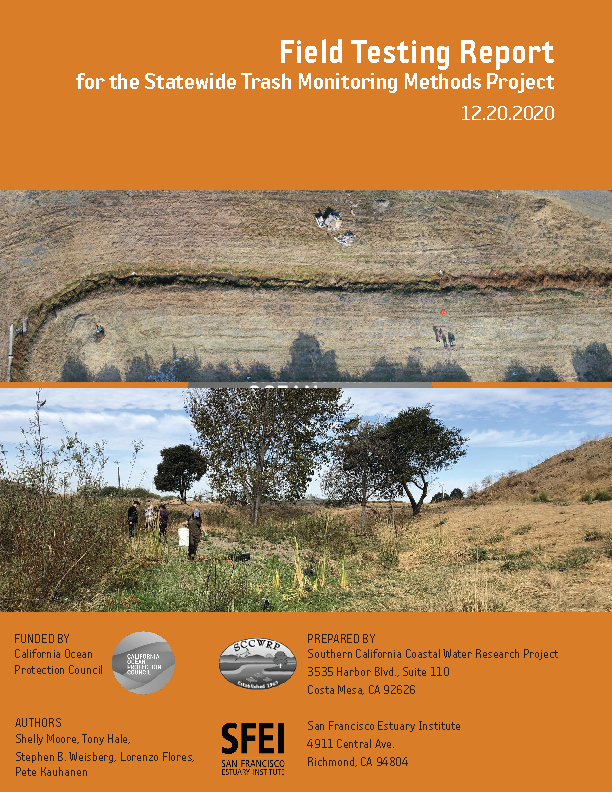Field Testing Report: California Trash Monitoring Methods
2021. Field Testing Report: California Trash Monitoring Methods. SFEI Contribution No. 1026. San Francisco Estuary Institute: Richmond, Calif.
 Trash has received renewed focus in recent years as policy makers, public agencies, environmental organizations, and community groups have taken many steps towards trash quantification and management across California. The range of management actions is matched by the diversity of monitoring approaches, designed to determine key attributes associated with trash pollution on California’s lands and in its waterways.
Trash has received renewed focus in recent years as policy makers, public agencies, environmental organizations, and community groups have taken many steps towards trash quantification and management across California. The range of management actions is matched by the diversity of monitoring approaches, designed to determine key attributes associated with trash pollution on California’s lands and in its waterways.
This report describes the field testing associated with a project designed to validate the accuracy, precision, and practicality of several trash monitoring methods, practiced across the state. Additionally, the project measured the efficacy of a novel monitoring method designed to detect trash via remote sensing and machine learning. Readers will find details about each respective method -- the specific approach to
landscape characterization, the qualitative or quantitative measures undertaken, the team-based quality assurance for data collection -- as well as the approach that the testing team adopted to ensure efficient, accurate, and useful validation of the methods.
Because the validation efforts integrated multiple methods, using multiple teams at a selection of common sites, the field testing report yields useful statistical information not only about each method individually, but about the comparability of the results. The report illustrates the
correlation factor associated with different forms of trash metrics, associated with different methods practiced on the same assessment sites. The results illustrated a generally high degree of correlation among different methods, which promises opportunities to compare results meaningfully across methods.
Furthermore, this field testing report provides quantitative measures to illustrate the repeatability of each method, the differences and insights yielded by assessment site sizing criteria varying among methods, the transferability / teach-ability of each method among trash monitoring practitioners, and how the degrees of accuracy might aid programs in performing mass balance analysis of known sources
to trash detected in a given site.
Regarding innovation, the project team leveraged multiple on-the-ground methods and special testing scenarios to compare conventional and novel (aerial) assessments to measure the relative accuracy and precision of this emergent technology that might address some of the resource constraints that currently limit the broader or more frequent deployment of conventional trash assessment methods. The analyses captured in this field testing report offer specific quantitative measures of the accuracy (bias), precision (repeatability), practicality and cost associated with each method. This information is subsequently used to inform a companion summary analysis found in the Trash Monitoring Playbook, which is designed to evaluate the applicability of the monitoring methods to address classes of
monitoring questions.
Related Projects, News, and Events:
 California Trash Monitoring Methods Project (Project)
California Trash Monitoring Methods Project (Project)
The California Ocean Protection Council (OPC), in close partnership with the State Water Board, has recognized the importance of standard methods for trash monitoring and has funded this project. The Southern California Coastal Water Research Project (SCCWRP) and San Francisco Bay Estuary Institute (SFEI) have partnered up to test multiple trash monitoring methods with a goal of developing a library of methods with known levels of precision, accuracy, and cross-comparability of results, and linking these methods to specific management questions.
 California Trash Monitoring Playbook now available (News)
California Trash Monitoring Playbook now available (News)
With the Ocean Protection Council-funded trash monitoring project concluded, the project team is eager to deliver its results to you. The team has compiled its data, composed its reports, and is now ready to share with you two reports, intended for use by trash-monitoring practitioners and the diverse constellation of stakeholders who benefit from trash-monitoring efforts. Now available on trashmonitoring.org are:
